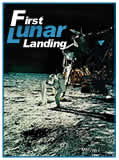

 July
20, 1969. "Houston, Tranquility Base here. The Eagle has landed."
Television and radio waves carried Commander Neil Armstrong's historic
exclamation to people around the world. Apollo 11’s moon landing
launched a new era in human exploration and renewed the rush to gather
vital scientific information about the dangers of living and working in
space.
July
20, 1969. "Houston, Tranquility Base here. The Eagle has landed."
Television and radio waves carried Commander Neil Armstrong's historic
exclamation to people around the world. Apollo 11’s moon landing
launched a new era in human exploration and renewed the rush to gather
vital scientific information about the dangers of living and working in
space.
Three years and several missions later, NASA was preparing to launch Apollo
17. On August 2, 1972, five months before the scheduled mission launch,
the sun erupted. A burst of radioactive particles hurtled towards the
earth and moon. An estimated 100,000,000 kilograms (100 billion kg) of
atomic particles, a mass equivalent to all the water in Lake Ontario,
sped towards the moon at very high speeds. Solar weather forecasters called
the August, 1972, solar flare a solar proton event, an extremely large
coronal mass ejection that spewed vast amounts of high-energy protons
into space with a force hundreds of times greater than the most violent
volcanic eruptions. The radioactive particles traveled the 93 million
miles (150 million km) from the sun to the moon in hours.
The first wave from this solar event bathed the earth and moon in X-rays.
During a solar proton event, an intense dose of X-rays and microwaves
forecasts the arrival of energized solar protons. An astronaut standing
on the sun side of the moon would have been engulfed in this deadly storm
of electromagnetic radiation and radioactive particles. Some experts believe
the astronauts would have received a dose of more than 5,000 rems of radiation,
five times the lethal dose for most people. This amount of radiation would
have killed the astronauts inside their space ship as well. Fortunately
for NASA the storms of this period of solar maximum subsided by December
and the astronauts of Apollo 17 conducted their mission in safety.
Today, scientists are constantly gathering data from the sun and trying
to learn how to predict major solar weather events. Accurate solar weather
predictions are needed to help the astronauts aboard the space station
prepare for dangerous bursts of solar radiation.
